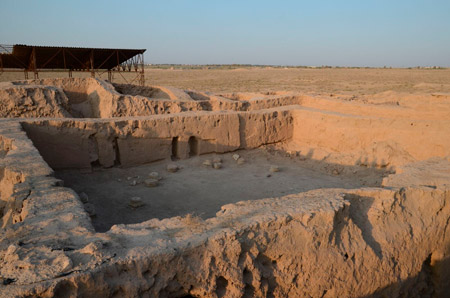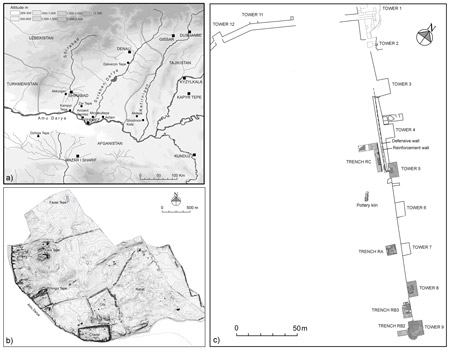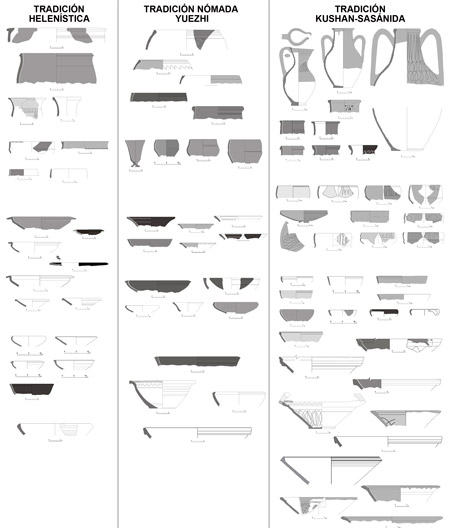With the main purpose of a comprehensive historical and archaeological knowledge and understanding of ancient Mediterranean cultures, in 2006 the ERAAUB team started a new research line to evaluate, from a broader chrono-spatial framework, those historical processes that occurred in parallel in large areas spanning from the western Mediterranean to Central Asia. As an example, it should be noted that the introduction of agriculture and animal domestication, originated in the Middle East, spread simultaneously in the Iberian Peninsula and Central Asia; migration of Indo-Aryans of northern Black Sea brought the same family of languages (Celtic) in both regions, which were integrated into large networks of trade and cultural exchange from the Bronze Age; after the arrival of Alexander the Great in Central Asia, both territories were under Greek cultural influence, while Islam spread in the two regions in parallel. In order to understand the Mediterranean as a zone consistently integrated into a comprehensive spatial framework, the team has developed an important research line focused on the study of past complex societies living in the historical region of Bactria (Central Asia). This territory was connected with many other Eurasian regions by the Silk Road, which linked the Eurasian steppes to the Indian subcontinent and the Mediterranean with China. Therefore, it has witnessed an important cultural exchange between sedentary populations, nomadic and semi-nomadic ethnic groups, also promoted by major migration processes of Indo-Aryan, Iranian, Greek Macedonians, Turks, Mongols and Semites. Specifically, the investigation performed by the team aims at proposing a new historical and archaeological perspective on the various socio-economic realities (sedentary agricultural communities and the nomadic and semi-nomadic herders of the steppes) that coexisted in ancient Bactria from the Bronze Age to the Islamic period and formed great historical-cultural entities (Oxus Bronze Age Cultural Complex, Achaemenid Empire, Hellenistic, Seleucid, Greco-Bactrian, nomadic Yuezhi, Kushan, Kushano-Sasanian and Islamic). Three main branches of the research are developed in parallel:
References
Angás, J., Uribe, P., Ariño Gil, A., Gurt Esparraguera, J.M., Martínez Ferreras, V., Pidaev, S.R. (2019). A multi-scalar photogrammetric recording approach in Termez (Uzbekistan), The International Archives of the Photogrammetry, Remote Sensing and Spatial Information Sciences, Volume XLII-2/W15, 93–100.
Angourakis, A., Rondelli, B., Stride, S., Rubio-Campillo, X., Balbo, A.L., Torrano, A., Martínez Ferreras, V., Madella, M., Gurt-Esparraguera, J.M. (2014), Land Use Patterns in Central Asia. Step 1: The Musical Chairs Model, Journal of Archaeological Method And Theory, 21(2), 405–425.
Angourakis, A., Salpeteur, M., Martínez, V., Gurt, J.M. (2017). The Nice Musical Chairs Model: Exploring the role of competition and cooperation between farming and herding in the formation of land use patterns in arid Afro-Eurasia, Journal of Archaeological Method And Theory, 24(4), 1177–1202.
Fusaro, A., Martínez Ferreras, V., Gurt Esparraguera, J.M., Angourakis, A., Pidaev, S.R., Baratova, L. (in press). Islamic Pottery from Ancient Termez (Uzbekistan): New Archaeological and Archaeometric Data, Archéosciences.
Gurt Esparraguera, J.M., Pidaev, S.R. (2009). IPAEB. Preliminary Report of the work of the International Pluridisciplinary Archaeological Expedition to Bactria (2009), vol. IV, Universitat de Barcelona, Barcelona.
Gurt Esparraguera, J.M., Pidaev, S.R. (2010). IPAEB. Preliminary Report of the work of the International Pluridisciplinary Archaeological Expedition to Bactria (2010), vol. V, Universitat de Barcelona, Barcelona.
Gurt Esparraguera, J.M., Ariño Gil, E. (2011). Los recintos fortificados de la Ciudadela y Tchinguiz Tepe (Termez, Uzbekistán). Entre los períodos Greco-Bactriano y Kushán-Sasánida. Informes y Trabajos 9. Excavaciones en el exterior 2011, pp. 751-766.
Gurt Esparraguera, J.M., Pidaev, S.R. Rauret, A.M., Stride, S. (2006). IPAEB. Preliminary Report of the First Season work of the International Pluridisciplinary Archaeological Expedition to Bactria (2006), vol. I, Universitat de Barcelona, Barcelona.
Gurt Esparraguera, J.M., Pidaev, S.R. Rauret, A.M., Stride, S. (2007). IPAEB. Preliminary Report of the First Season work of the International Pluridisciplinary Archaeological Expedition to Bactria (2007), vol. II, Universitat de Barcelona, Barcelona.
Gurt Esparraguera, J.M., Pidaev, S.R. Rauret, A.M., Stride, S. (2008). IPAEB. Preliminary Report of the work of the International Pluridisciplinary Archaeological Expedition to Bactria (2008), vol. III, Universitat de Barcelona, Barcelona
Gurt, Esparraguera, J.M., Martínez Ferreras, V., Ariño Gil, E. (2010). El recinto fortificado de Tchinguiz Tepe (Termez, Uzbekistán). Entre el período Greco-Bactriano y el período Kushan-Sasánida. Infromes y Trabajos 7, pp. 385–397.
Gurt Esparraguera, J.M., Ariño Gil, E., Martínez Ferreras, V., Pidaev, S.R. (2015). The Buddhist occupation of Tchingiz Tepe (Termez, Uzbekistan) in the Kushan period through the ceramic contexts, Archaeological Research in Asia, 3, 19–33.
Leriche, P. (2010). L'ancienne Termez dans l'antiquité. Journal of Historical, Philological and Cultural Studies, 1, 153–190.
Leriche, P. (2013). L'apport de la Mission archaéologique franco-ouzbèque (MAFOuz) de Bactriane du Nord à l'histoire de l'Asie centrale. J. Bendezu-Sarmiento (ed.), L'achéologie française en Asie centrale. Nouvelles recherches et enjeux socioculturels, 21-22. De Boccard, Paris, Bishkek, Kabul, pp. 135–164.
Martínez Ferreras, V., Ariño Gil, E., Gurt Esparraguera, J.M., Pidaev, S.R. (2014). The enclosure of Tchingiz Tepe (ancient Termez, Uzbekistan) during the Kushan and Kushan-Sassanian periods. Archaeological stratigraphy and 14C dating analyses, Iranica Antiqua, 49, 413–474.
Martínez Ferreras, V., Gurt Esparraguera, J.M., Hein, A., Pidaev, S.R., Rtveladze, E.V., Bolelov, S.B. (2016). Tableware in the Hellenistic tradition from the city of Kampyr Tepe in ancient Bactria (Uzbekistan), Archaeometry, 58(5), 736–764.
Martínez, V., Angourakis, A., Hein, A., Gurt, J.M., Sverchkov, L.M., Sánchez del Corral, A. (2018). Pottery in Hellenistic tradition from ancient Bactria: The Kurganzol fortress (Uzbekistan, Central Asia), Journal of Archaeological Science Reports, 21, 1044–1054.
Martínez Ferreras, V., Angourakis, A., Hein, A., Aulinas-Juncà, M., Garcia-Vallés, M., Gurt Esparraguera, J.M., Ariño-Gil, E., Sánchez-Corral, A., Pidaev, S.R. (2019a). Assessing Hellenistic to nomadic cultural patterns through pottery in ancient Termez, Uzbekistan, Geoarchaeology. An International Journal, 34, 540–564.
Martínez Ferreras, V., Fusaro, A., Gurt-Esparraguera, J.M., Ariño-Gil, E., Pidaev, S.R., Angourakis, A. (2019b). The Islamic Ancient Termez Through the Lens of Ceramics: A New Archaeological and Archaeometric Study, IRAN. Journal of the British Institute of Persian Studies. Doi: 10.1080/05786967.2019.1572430.
Martínez Ferreras, V., Ariño Gil, E., Gurt Esparraguera, J.M., Pidaev, S.R. (in press), Archaeometric characterisation of Kushan and Kushano-Sasanian pottery from Tchingiz Tepe (Termez, south Uzbekistan). En H.-P. Francfort y N. Boroffka, The Roxiana Project. Archaeological Researches on Metal and Pottery Assemblages from the Oxus Basin to the Indus Valley during Protohistory. Archäologie in Iran und Turan, Berlin: Dietrich Reimer Verlag.
Molera, J., Martínez Ferreras, V., Fusaro, A., Gurt Esparraguera, Gaudenzia, M., Pidaev, S.R., Pradell, T. (2020). Islamic glazed wares from ancient Termez (southern Uzbekistan). Raw materials and techniques, Journal of Archaeological Science: Reports, 29. Doi: 10.1016/j.jasrep.2019.102169.
Pidaev, S.R., Kato, K., (2010). The excavation of the north and west (central) hill of Kara-Tepa (1998–2007), Sovyeshchaniye ryegionalnykh spyetsyalistov, Kulturnoye naslyediye Tsyentralnoy Azii i vklad Yaponii, Tashkent and Samarkand, 12–16 marta 2008 goda, National Institute for Research in Cultural Exchange Tokio, National Commission of Uzbekistan for UNESCO Affairs, Tashkent, pp. 157–185.
Sánchez del Corral, A., Thum, H. (2012). Geomorphology and Late Holocene morphogenesis of Tchinguiz Tepe hill (Old Termez, Uzbekistan, Central Asia). Quaternary International, 281, 89–104.
Tsantini, E., Martínez Ferreras, V., Ariño Gil, E., Gurt Esparraguera, J.M.; Pidaev, S.R. (2016), Pottery production in the Buddhist communities in Central Asia: The Kushan-Sassanian pottery workshop of Kara Tepe (Termez, Uzbekistan), Archaeometry, 58(1), 35–56.






